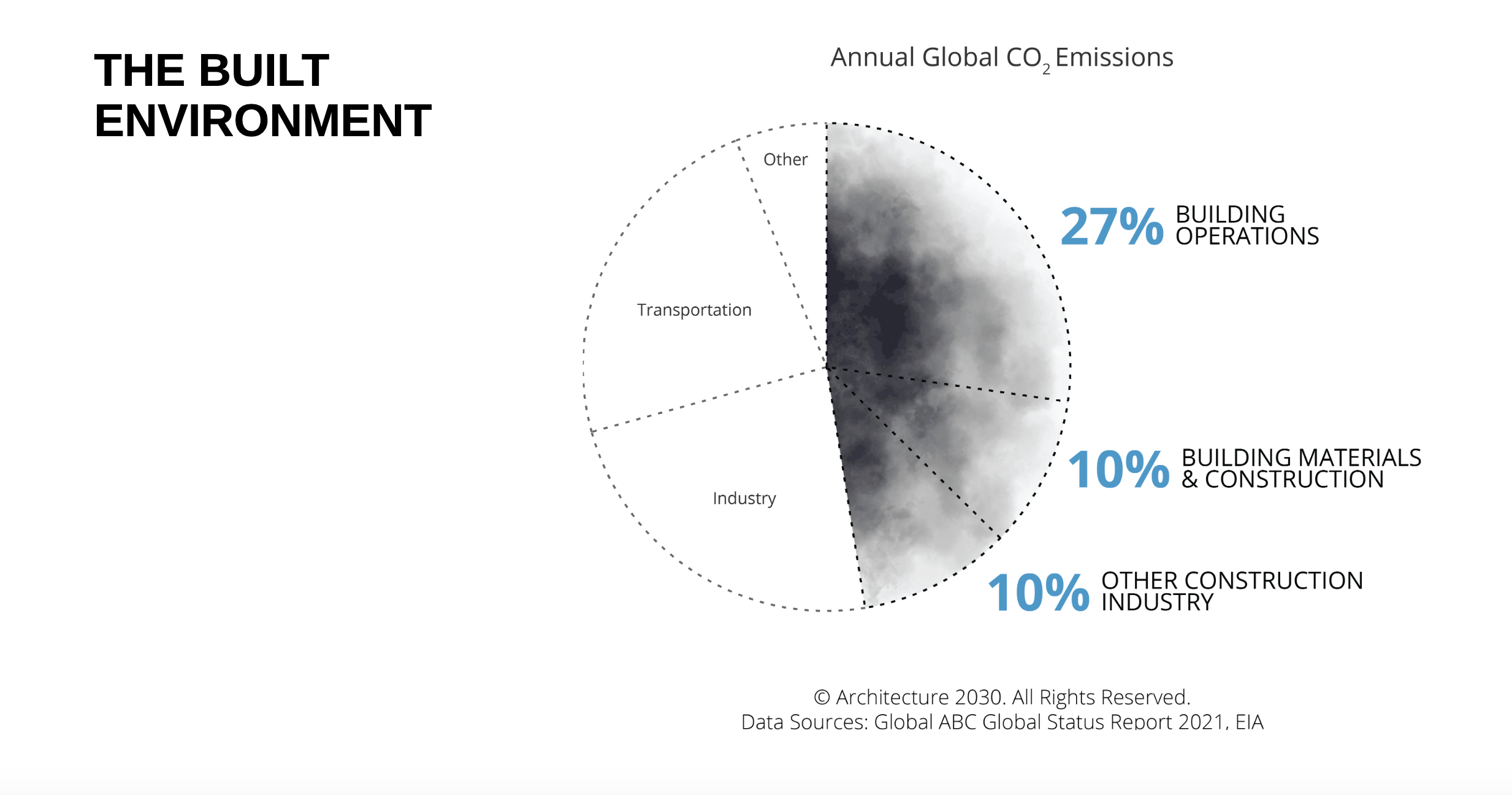Written By: Cleo Cosens
Reading Time: 3 minutes 50 seconds
It is more evident than ever how greenhouse gas emissions (GHG) are affecting our planet. Look at the recent news headlines in the UK. The Met Office announced that “For the first time on record temperatures in the UK have exceeded 40°C” and announced a UK first ‘Red Alert’. (Met Office, 2022). There are many contributors to GHG emissions, however, this article focuses on the role the built environment plays in global warming.
What Role Does The Built Environment Play In Global Warming?

Source: (Architecture 2030, 2021)
The graph above illustrates the annual global Co2 emissions emitted by the built environment which is categorised into Construction, Industry, Transportation, and Other. More than half of GHGs produced by the construction sector belong to ‘Building Operations’. Interestingly, it is the largest competing segment battling against ‘Industry’.
Looking at GHG emissions per industry, nearly 50% of the world’s GHG emissions are generated by the construction sector. The major contributors to these emissions are materials used during the construction process, as well as, electricity use – driven by HVAC, lights, and infrastructure (Deloitte, 2020).
It is critical to understand that building operations play a large role and why? In the UK, nearly 80% of buildings in 2050 have already been built and will be in use (UK Parliament, 2022). Consequently, most existing buildings were not designed with net carbon zero in mind. Therefore, to achieve our 2050 net carbon zero goal, all current building stock must embrace energy efficiency methods, green strategies, and sustainability practices.
How Can We Reduce Emissions In The Built Environment?
Being sustainable is about the long-term, not the short term. It’s important to recognise that it’s about welcoming a variety of strategies, methods, policies, and processes to achieve our ESG goals and commitments. Below are only three suggestions out of many that are available.
RETROFITTING YOUR BUILDING
A UKGBC analysis found that by 2050, commercial buildings must reduce energy consumption by 59% to align with the Paris Agreement. (UKGBC, 2022) As previously mentioned, approximately 80% of the UK’s existing building stock will still be in use by 2050, therefore, making existing buildings, not as energy and waste efficient. Retrofitting involves modifying the building structure or system to improve building performance and tenant well-being. It could mean upgrading lighting from fluorescent to LED, adding further modern controls to LED beyond simple dimming, creating waste strategies, installing low-carbon energy technologies (such as solar power), upgrading HVAC systems, and more.
ADOPTING TECHNOLOGY
In an existing building, the biggest challenge is the integration of incumbent systems. This is due to the closed proprietary nature which is all too common in the industry. In reality, if we integrate all of a building’s systems, it can lead to incremental energy savings of 8-28% over conventional HVAC and lighting operations. Furthermore, the power of automation yields great results. Commercial buildings can save 10-15% on energy through this, while advanced features like demand-controlled HVAC can save an additional 5-10%. (The World Economic Forum, 2021)
COLLABORATION
At the end of the day, to remain sustainable it’s about making lifestyle changes. Not only to make changes as individuals but changes in how we interact with each other and the environment. Let’s use building systems as an analogy. It works in the building’s favour if all systems integrate and collaborate with each other so, that it can gain a holistic, accurate, and insightful representation of its operations and processes. This creates more educated and evidence-based decisions to achieve optimal results. The same principle goes with people. For industry, it means contractors, partners, and suppliers working together, sharing information, and providing support to achieve and surpass their ESG targets and sustainability goals consistently and continuously. Thinking long term about what is best for our future.
Let’s Wrap This Up
The built environment plays a massive role in GHG emissions, so sustainability is key to protecting our people and planet. Technology is part of the solution; however, it goes beyond having a ‘one solution, solves all’ mindset. We need to collaborate and support each other to reach the same goal to allow future generations to prosper.
To find out how to reduce energy within your building and gain visibility of your building operations to create evidence-backed decisions and strategies. Contact us to find out about how we can support your business and sustainability goals through the Pulse Cloud.
